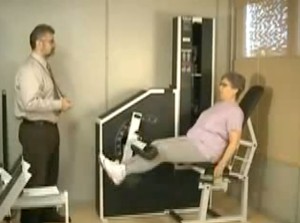Exercising in your street clothes suggests an easy walk around the block, at most climbing three flights of stairs. Better than nothing, but less than what you truly want out of your exercise program.
You’d like all the benefits of regular exercise and finding the time is the biggest hurdle. And maybe all those hyper-trim bodies in spandex moving to throbbing music play a part, too.
Weight-training with a very slow protocol
Slow-motion strength training is a technique that has been around for a couple decades and as its name suggests has you lifting weights very slowly (10 seconds positive) and lowering them very slowly (10 seconds negative). This slow-motion strength training, done on machines instead of with free weights, allows your muscles to work at their maximum in a very safe and effective manner. The slow-motion also eliminates sweating which allows you to skip the hassle of gym clothes and showering. You can come directly from work and return directly to work and the only people that will notice you have exercised are you and your trainer.
Example of a slow-motion exercise
The leg press machine looks like a chair with handles on either side of the seat and a big vertical plate about a bent-leg length in front of you. You sit on the chair, hold onto the handles, put your feet on the plate and slowly extend your legs, then slowly contract them. You repeat this timed motion until you reach 2 minutes. The weights you are lifting are in vertical stacks, separate from the foot plate and on either side of the plate.
Many different slow-motion exercises are available to choose from, and a typical routine uses a combination of several. You can use the slow-motion protocol with any weight machine. The personal trainers at our studio work with each client to design a well-rounded exercise routine that provides a safe and effective workout.
Just how valuable is your time?
Are effectiveness, efficiency, productivity the watchwords for your professional life? Make them the watchwords of your exercise life.
With slow-motion training all you need is 20 minutes two times per week. That is how powerful slow-motion strength training is. More than two sessions per week and you are going backwards, taxing your body in a way in which it can’t fully recover in time for the next session. During the recovery interval your body is repairing muscle and growing new muscle. Making sure you have a recovery interval is how you get stronger.
Much safer than regular weight training
Slow-motion strength training is one of the safest ways to exercise because there is no momentum in the movement and the exercise can safely be stopped at the slightest hint of danger or pain.
If you’ve been listening to your colleagues you’ve probably heard the more active ones complain of this injury or that, maybe even using the injury as a status symbol for how hard they exercise and how fit they are.
Well, injury is no sign of fitness nor is it a given when exercising properly. The protocol of slow-motion strength training can save you from injury in two ways:
- it can keep you from injuring yourself while exercising and
- it can help you heal injuries, even those that have lasted decades.
Strength training does need to tax your muscles to be effective but it doesn’t need to tax your time or your safety.
Your turn to experience working out in your street clothes
With slow-motion strength training, exercising in your street clothes can be your reality.
You can save time, avoid the spandex and mirrors and efficiently get that strong, functional body that will meet the challenges you ask of it.


